What Will Happen When Betelgeuse Explodes?









What Will Happen When Betelgeuse Explodes?
“Every star will someday run out of fuel in its core, bringing an end to its run as natural source of nuclear fusion in the Universe. While stars like our Sun will fuse hydrogen into helium and then – swelling into a red giant – helium into carbon, there are other, more massive stars which can achieve hot enough temperatures to further fuse carbon into even heavier elements. Under those intense conditions, the star will swell into a red supergiant, destined for an eventual supernova after around 100,000 years or so. And the brightest red supergiant in our entire night sky? That’s Betelgeuse, which could go supernova at any time.”
One of the most sobering cosmic truths is that every star in the Universe will someday run out of fuel and die. Once its core fuel is exhausted, all it can do is contract under its own gravitational pull, fusing heavier and heavier elements until it can go no further. Only the most massive stars, capable of continuing to fuse carbon (and even heavier elements) will ever create the Universe’s ultimate cataclysmic event: a Type II, or core collapse, supernova. Stars that are fusing carbon (and up) appear to us today as red supergiants, and the brightest red supergiant as seen from Earth is Betelgeuse. Sometime in the next 100,000 years or so, Betelgeuse will go supernova. When it does, it will emit incredible amounts of radiation, become intrinsically brighter than a billion suns and and be easily visible from Earth during the day. But that’s not all.
What’s the full story on what will happen when Betelgeuse goes supernova? Come get the science today!
More Posts from Riekod and Others

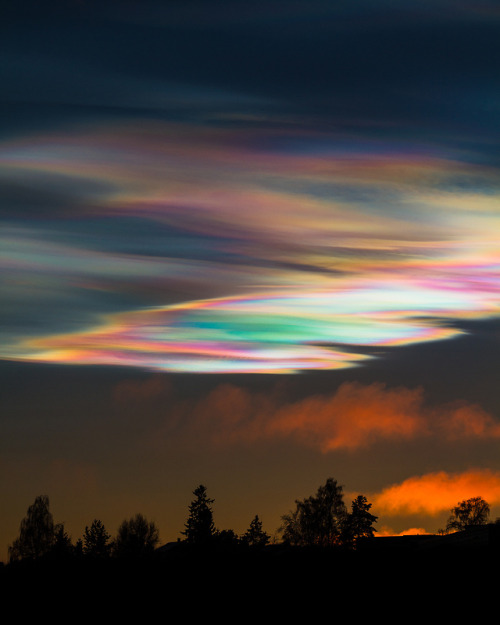
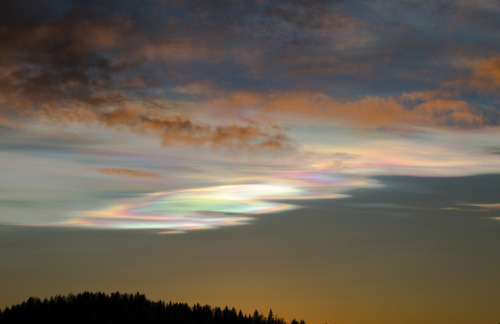

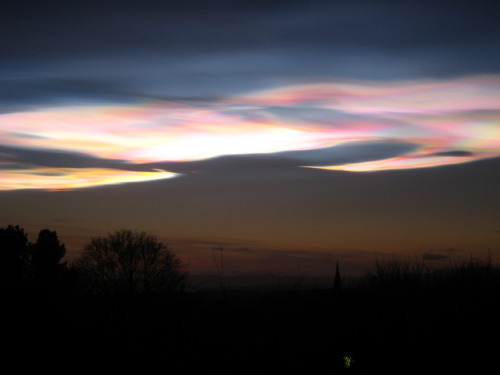


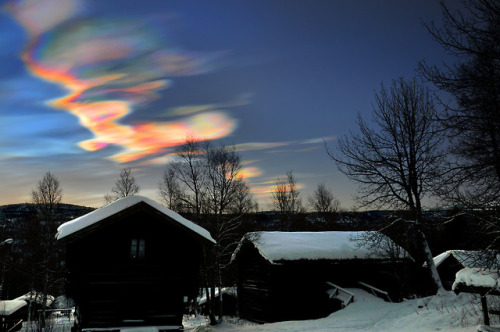
Polar stratospheric clouds or PSCs, also known as nacreous clouds, are clouds in the winter polar stratosphere at altitudes of 15,000–25,000 meters (49,000–82,000 ft). They are best observed during civil twilight when the sun is between 1 and 6 degrees below the horizon as well as in winter and in more northerly latitudes. They are implicated in the formation of ozone holes. The effects on ozone depletion arise because they support chemical reactions that produce active chlorine which catalyzes ozone destruction, and also because they remove gaseous nitric acid, perturbing nitrogen and chlorine cycles in a way which increases ozone destruction.
source / images: x, x, x, x, x, x, x, x
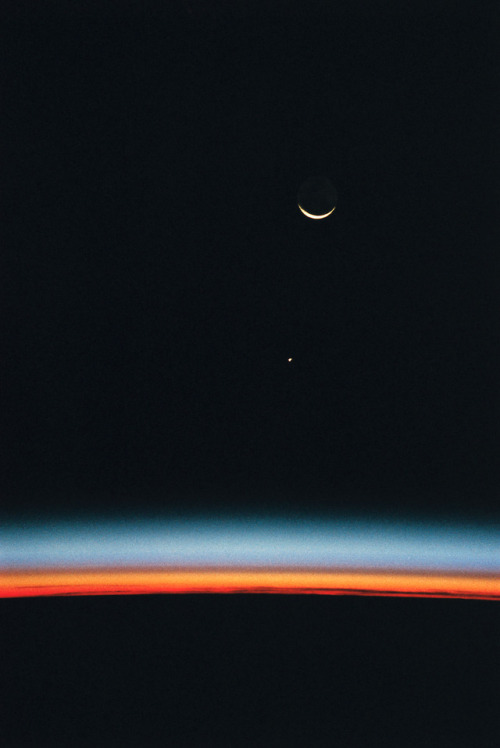
This scene, captured with a 35mm camera from inside the Space Shuttle Endeavour, shows Jupiter rising above the airglow over Earth’s horizon. The crescent Moon is at top frame.
Credit: NASA
As I get older I’m finding that a lot of the “intellectuals” I used to admire are actually just condescending and pretentious. And also realizing how much more important it is to be present, considerate, and empathetic because nobody really knows what they’re talking about and anyone who claims to know everything about anything is feeding you bs.
It’s sad how much of what is taught in school is useless to over 99% of the population.
There are literally math concepts taught in high school and middle school that are only used in extremely specialized fields or that are even so outdated they aren’t used anymore!
This is how far into the earth humans have dug so far.
List of extrasolar candidates for liquid water
The following list contains candidates from the list of confirmed objects that meet the following criteria:
Confirmed object orbiting within a circumstellar habitable zone of Earth mass or greater (because smaller objects may not have the gravitational means to retain water) but not a star
Has been studied for more than a year
Confirmed surface with strong evidence for it being either solid or liquid
Water vapour detected in its atmosphere
Gravitational, radio or differentation models that predict a wet stratum
55 Cancri f

With a mass half that of Saturn, 55 Cancri f is likely to be a gas giant with no solid surface. It orbits in the so-called “habitable zone,” which means that liquid water could exist on the surface of a possible moon. ]
Proxima Centauri b

Proxima Centauri b is an exoplanet orbiting in the habitable zone of the red dwarfstar Proxima Centauri, which is the closest star to the Sun and part of a triple star system. It is located about 4.2 light-years from Earth in the constellation of Centaurus, making it the closest known exoplanet to the Solar System.
Gliese 581c

Gliese 581c gained interest from astronomers because it was reported to be the first potentially Earth-like planet in the habitable zone of its star, with a temperature right for liquid water on its surface, and by extension, potentially capable of supporting extremophile forms of Earth-like life.
Gliese 667 Cc

Gliese 667 Cc is an exoplanet orbiting within the habitable zone of the red dwarf star Gliese 667 C, which is a member of the Gliese 667 triple star system, approximately 23.62 light-years away in the constellation of Scorpius.
Gliese 1214 b

Gliese 1214 b is an exoplanet that orbits the star Gliese 1214, and was discovered in December 2009. Its parent star is 48 light-years from the Sun, in the constellation Ophiuchus. As of 2017, GJ 1214 b is the most likely known candidate for being an ocean planet. For that reason, scientists have nicknamed the planet “the waterworld”.
HD 85512 b

HD 85512 b is an exoplanet orbiting HD 85512, a K-type main-sequence star approximately 36 light-years from Earth in the constellation of Vela.
Due to its mass of at least 3.6 times the mass of Earth, HD 85512 b is classified as a rocky Earth-size exoplanet (<5M⊕) and is one of the smallest exoplanets discovered to be just outside the inner edge of the habitable zone.
MOA-2007-BLG-192Lb

MOA-2007-BLG-192Lb, occasionally shortened to MOA-192 b, is an extrasolar planet approximately 3,000 light-years away in the constellation of Sagittarius. The planet was discovered orbiting the brown dwarf or low-mass star MOA-2007-BLG-192L. At a mass of approximately 3.3 times Earth, it is one of the lowest-mass extrasolar planets at the time of discovery. It was found when it caused a gravitational microlensing event on May 24, 2007, which was detected as part of the MOA-II microlensing survey at the Mount John University Observatory in New Zealand.
Kepler-22b

Kepler-22b, also known by its Kepler object of interest designation KOI-087.01, is an extrasolar planet orbiting within the habitable zone of the Sun-like star Kepler-22. It is located about 587 light-years (180 pc) from Earth in the constellation of Cygnus. source
If Earth had Saturn’s Rings
From an excellent post by Jason Davis
From Washington, D.C., the rings would only fill a portion of the sky, but appear striking nonetheless. Here, we see them at sunrise.

From Guatemala, only 14 degrees above the equator, the rings would begin to stretch across the horizon. Their reflected light would make the moon much brighter.

From Earth’s equator, Saturn’s rings would be viewed edge-on, appearing as a thin, bright line bisecting the sky.

At the March and September equinoxes, the Sun would be positioned directly over the rings, casting a dramatic shadow at the equator.

At midnight at the Tropic of Capricorn, which sits at 23 degrees south latitude, the Earth casts a shadow over the middle of the rings, while the outer portions remain lit.

via x
What if we can breathe in space but the Government just tells us we cant so that we dont try to escape.
sure i guess sex is okay but have you ever closed a dozen tabs after finishing an academic paper
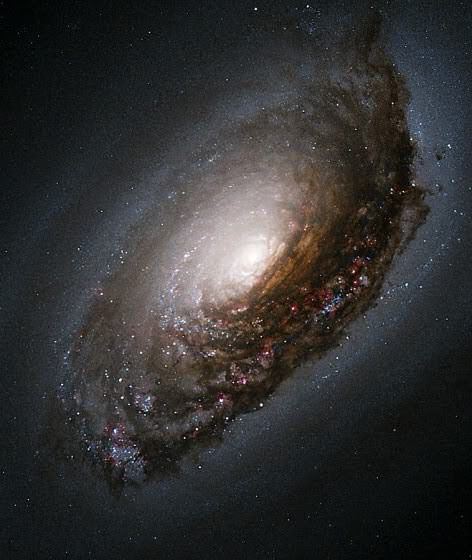
M64, The Black Eye Galaxy
-
 elise1917 liked this · 1 year ago
elise1917 liked this · 1 year ago -
 sailorneptune1993 liked this · 5 years ago
sailorneptune1993 liked this · 5 years ago -
 caedr reblogged this · 5 years ago
caedr reblogged this · 5 years ago -
 gglitchshit liked this · 5 years ago
gglitchshit liked this · 5 years ago -
 wondersofstars reblogged this · 5 years ago
wondersofstars reblogged this · 5 years ago -
 lostredsupergiantstars reblogged this · 5 years ago
lostredsupergiantstars reblogged this · 5 years ago -
 lostredsupergiantstars liked this · 5 years ago
lostredsupergiantstars liked this · 5 years ago -
 rovertdragon liked this · 5 years ago
rovertdragon liked this · 5 years ago -
 mewhunter9 reblogged this · 5 years ago
mewhunter9 reblogged this · 5 years ago -
 decaffeinated-nini reblogged this · 5 years ago
decaffeinated-nini reblogged this · 5 years ago -
 decaffeinated-nini liked this · 5 years ago
decaffeinated-nini liked this · 5 years ago -
 earthtoambur reblogged this · 5 years ago
earthtoambur reblogged this · 5 years ago -
 bonesawcowboy liked this · 5 years ago
bonesawcowboy liked this · 5 years ago -
 jokingmaiden liked this · 5 years ago
jokingmaiden liked this · 5 years ago -
 taenquility reblogged this · 5 years ago
taenquility reblogged this · 5 years ago -
 taenquility liked this · 5 years ago
taenquility liked this · 5 years ago -
 bigdiccisbackintown liked this · 5 years ago
bigdiccisbackintown liked this · 5 years ago -
 vhopies liked this · 5 years ago
vhopies liked this · 5 years ago -
 godisahuman liked this · 5 years ago
godisahuman liked this · 5 years ago -
 screaminglamps liked this · 5 years ago
screaminglamps liked this · 5 years ago -
 honeytiles liked this · 5 years ago
honeytiles liked this · 5 years ago -
 liebefreundin liked this · 5 years ago
liebefreundin liked this · 5 years ago -
 lighthouse-crow liked this · 5 years ago
lighthouse-crow liked this · 5 years ago -
 jadeblackwellsblog liked this · 6 years ago
jadeblackwellsblog liked this · 6 years ago -
 lele-jpg liked this · 6 years ago
lele-jpg liked this · 6 years ago -
 silbandobajito liked this · 6 years ago
silbandobajito liked this · 6 years ago -
 wheatu liked this · 6 years ago
wheatu liked this · 6 years ago -
 rivalrebel585-blog liked this · 6 years ago
rivalrebel585-blog liked this · 6 years ago -
 u-smell-like-candy liked this · 6 years ago
u-smell-like-candy liked this · 6 years ago -
 rain13121 reblogged this · 6 years ago
rain13121 reblogged this · 6 years ago -
 rain13121 liked this · 6 years ago
rain13121 liked this · 6 years ago -
 tieflingx liked this · 6 years ago
tieflingx liked this · 6 years ago